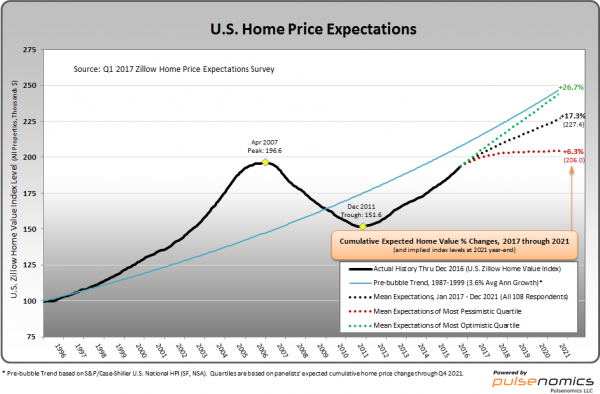On February 10, 2017, the Zillow Q1 2017 Home Price Expectations Survey results were released. This survey is done on a quarterly basis.
Two excerpts from the Press Release:
The quarterly survey, sponsored by Zillow and conducted by Pulsenomics LLC, asked more than 100 housing experts and economists what factors would have the greatest impact on U.S. housing this year. The most frequent answer was rising mortgage rates and their impact on mortgage affordability, with more than half of panelists selecting itii.
also:
Home values rose 6.8 percent in 2016. Overall, the experts surveyed predict home prices will rise 4.6 percent in 2017, then slow to 3 percent annual growth by 2019."Compared to their outlook in our previous survey just a few months ago, most of our panelists now expect somewhat stronger home value appreciation this year and next, as tight inventory conditions persist," said Pulsenomics founder Terry Loebs. "However, longer-term, the consensus still calls for decelerating prices, with the most pessimistic quartile of experts continuing to project negative inflation-adjusted returns for U.S. housing beyond 2017. The specter of rising mortgage rates and other affordability hurdles are clearly impacting these home value projections."
–
Various Q1 2017 Zillow Home Price Expectations Survey charts are available, including that seen below:
As one can see from the above chart, the average expectation is that the residential real estate market, as depicted by the U.S. Zillow Home Value Index, will continually climb.
The detail of the Q1 2017 Home Price Expectations Survey (pdf) is interesting. Of the 100+ survey respondents, only six (of the displayed responses) forecasts a cumulative price decrease through 2021, and only one of those forecasts is for a double-digit percentage decline. That forecast is from Mark Hanson, who foresees a 22.97% cumulative price decrease through 2021.
The Median Cumulative Home Price Appreciation for years 2017-2021 is seen as 4.55%, 8.68%, 11.82%, 14.70%, and 18.02% respectively.
For a variety of reasons, I continue to believe that even the most “bearish” of these forecasts (as seen in Mark Hanson’s above-referenced forecast) will prove too optimistic in hindsight. From a longer-term historical perspective, such a decline is very mild in light of the wild excesses that occurred over the “bubble” years.
I have written extensively about the residential real estate situation. For a variety of reasons, it is exceedingly complex. While many people continue to have an optimistic view regarding future residential real estate prices, in my opinion such a view is unsupported on an “all things considered” basis. Furthermore, from these price levels there exists outsized potential for a price decline of severe magnitude, unfortunately. I discussed this downside, based upon historical price activity, in the October 24, 2010 post titled “What’s Ahead For The Housing Market – A Look At The Charts.”
_____
The Special Note summarizes my overall thoughts about our economic situation
SPX at 2314.75 as this post is written

No comments:
Post a Comment